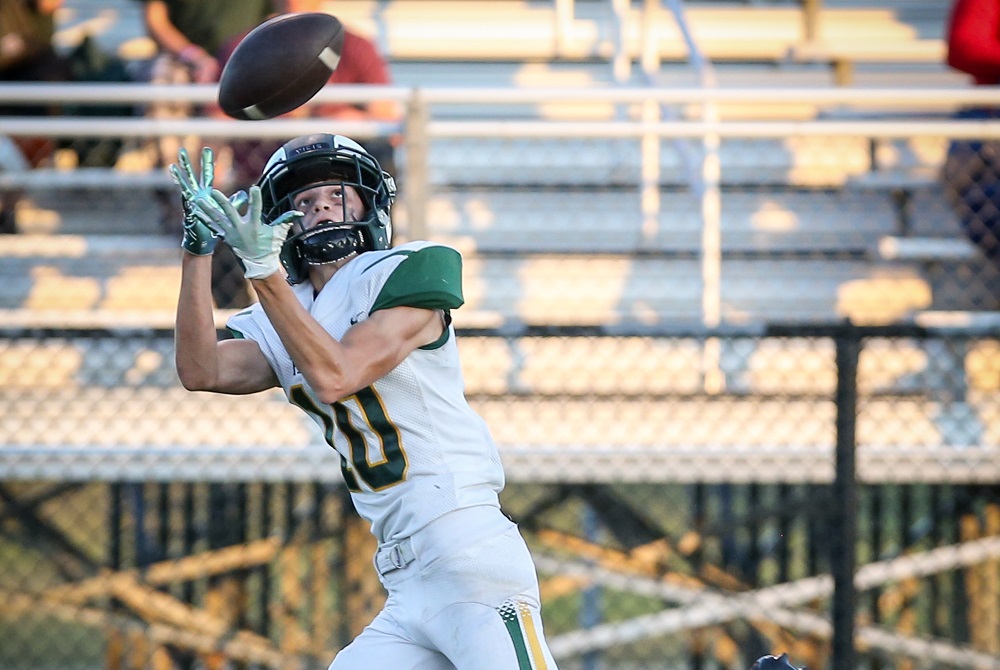
Inside Selection Sunday: Mapnalysis '15
October 26, 2015
By Geoff Kimmerly
Second Half editor
Consider that one hour Sunday night was the product of nine weeks of games on top of two more weeks of practice, hours of lifting weights, conditioning and camps and a total of six months of work at the MHSAA office, in addition to hours upon hours put in by athletic directors scheduling years in advance.
The anticipation for the release of another year's MHSAA Football Playoff pairings is matched by a giant exhale only after the results are broadcast on Fox Sports Detroit, streamed online and posted on locker room doors and Facebook walls all over our state.
 And then the fun begins again.
And then the fun begins again.
But the Selection Sunday Show is the favorite hour of the season for many fans across our state. And that’s why, for the fifth year, we’ll explain our most difficult decisions in this Mapnalysis 2015 breakdown of how we paired 272 teams that will play next month for championships across nine divisions.
For those familiar with our playoff selection process, or who have read this report in the past and don’t want a refresher on how we do what we do, skip the next section and go directly to the “Observations & Answers: 2015.” For the rest, what follows is an explanation of how we selected the playoff pairings during the morning hours Sunday, followed by how we made some of the toughest decisions and a few thoughts on the breakdown of the field.
Ground Rules
Our past: The MHSAA 11-player playoff structure – with 256 teams in eight divisions, and six wins equaling an automatic berth (or five wins for teams playing eight or fewer games) – debuted in 1999. An 8-player tournament was added in 2011, resulting in nine champions total each season.
The first playoffs were conducted in 1975 with four champions. Four more football classes were added in 1990 for a total of eight champions each fall. Through 1998, only 128 teams made the postseason, based on their playoff point averages within regions (four for each class) that were drawn before the beginning of the season. The drawing of Districts and Regionals after the end of the regular season did not begin until the most recent playoff expansion.
In early years of the current process, lines were drawn by hand. Dots representing qualifying schools were pasted on maps, one map for each division, and those maps were then covered by plastic sheets. Districts and Regionals literally were drawn with dry-erase markers.
Our present: After a late Saturday night tracking scores, we file in as the sun rises Sunday morning for a final round of gathering results we may still need (which can include making a few early a.m. calls to athletic directors). Re-checking and triple-checking of enrollments, what schools played in co-ops and opted to play as a higher class start a week in advance, and more numbers are crunched Sunday morning as the fields are set.
This season, there were a record-low 216 automatic qualifiers by win total – with the final 40 at-large then selected, by playoff-point average, one from each class in order (A, B, C, D) until the field was filled. There were only four Class D additional qualifiers with 5-4 or 4-4 (playing eight games) records from which we could choose – so after those four we added 12 teams each from Class A, Class B and Class C.
Those 256 11-player teams are then split into eight equal divisions based on enrollment, and their locations are marked on digital maps that are projected on wall-size screens and then discussed by nearly half of the MHSAA staff plus a representative from the Michigan High School Football Coaches Association. Only the locations themselves are marked (by yellow dots) – not records, playoff point averages or names of the schools or towns. In fact, mentions of those are strictly prohibited. Records and playoff points are not part of the criteria. Matchups, rivalries, previous playoff pairings, etc. also DO NOT come into play.
The same process is followed for organizing the 8-player bracket, with the difference that the 16 teams are selected purely on playoff-point average.
Geography rules: This long has been rule number one for drawing MHSAA brackets in any sport. Travel distance and ease DO come into play. Jumping on a major highway clearly is easier than driving across county-wide back roads, and that’s taken into consideration. Also, remember there’s only one Mackinac Bridge and hence only one way to cross between peninsulas – and boats are not considered a possible form of transportation. When opponents from both peninsulas will be in the same District, distance to the bridge is far more important than as the bird flies.
Tradition doesn’t reign: Every group of 32 dots is a new group – these 32 teams have not been placed in a bracket together before. How maps have been drawn in the past isn’t considered – it’s hard to say a division has been drawn in a certain way traditionally when this set of 32 teams is making up a division for the first time.
Observations & Answers: 2015
Go north with ease: For the most part, most Regional pairings were easier to draw than in past years. For the most part. Divisions 2 and 4 were not easy, specifically when it came to deciding which teams would be paired with an Upper Peninsula qualifier or a team from the Traverse City area. Keep in mind, distance on these maps isn’t based on how the bird flies, but how a bus would drive. In Division 2, that meant putting Muskegon, Muskegon Mona Shores and Grand Rapids Forest Hills Northern – near U.S. 31 and U.S. 131 – with Traverse City Central instead of sending Midland and Midland Dow west, up I-75 and then east-to-west again on more non-highway roads. In Division 4, we considered pairing Alma and Saginaw Swan Valley with Escanaba instead of Big Rapids and Remus Chippewa Hills. That decision came down to Big Rapids being about 14 miles closer to Escanaba than Swan Valley (Whitehall would go with Big Rapids and Chippewa Hills regardless.).
Four counties wide: Yes, on first glance it looks a little odd that Bay City John Glenn and Orchard Lake St. Mary’s would be in the same Division 3 District – but look at the map as a whole. Eight Division 3 teams are located south and mostly east of St. Mary’s, and John Glenn is the only team that could be considered in the northeastern quarter of the Lower Peninsula (Mount Pleasant and Gaylord are right down the middle and naturals to go with Sault Ste. Marie and Petoskey.). With the thumb playoff qualifiers of near-similar size in Division 4, there were no other options than to create this four-county trip between the Eaglets and Bobcats.
Semifinal selection: When all the Regional lines are drawn for a division, we also must figure out which Regionals will meet for Semifinals. This annually provides some challenges. Do we match east vs. west or north vs. south? If something seems iffy in four weeks when those games are played, again, keep in mind the entire map and entire Regionals that are matched up.
Scheduled strong: Because we’re looking only at dots on a map, we don’t see the matchups until everything is drawn – and in that way, we’re like everyone else. It wasn’t lost on us that two 9-0 teams will have road games this week or three 5-4 at-large qualifiers will be at home. For those 9-0 teams, it’s true: there’s nothing more they could’ve done on the field. But here’s why they will travel.
- Clinton, in Division 6, hasn’t lost a regular-season game since 2011, and in fact plays in a strong Tri-County Conference made up of Class C schools and one Class D. Four of eight from the league made the playoffs, and the competition was so strong that Morenci and Petersburg-Summerfield will host games in Division 8. But Clinton’s opponent, Monroe St. Mary Catholic Central, while it did have one loss, fell to one-loss Class B Lansing Catholic – and the Falcons played eight Class B and one Class A school this season. Beating a Class B team is worth 16 points more than beating a Class C and 32 more than beating a Class D (with those points then divided over the number of games a team plays that season) – and all of that made the difference in St. Mary’s final eight-point playoff average edge over Clinton.
- Saugatuck in Division 7 is a similar story. The Indians are one of three undefeated teams in their District, and did play a pair of Class B opponents. But by no fault of their own, especially in league play where the schedule is set, Saugatuck didn’t face a team this season that won more than five games. Hesperia played three Class B opponents including one that finished 6-3 – enough for the slim 1.8 points more in playoff average that earned the Panthers homefield advantage. Pewamo-Westphalia has the highest average in the District and didn’t play a Class B – the Pirates actually played three Class D teams. But they also beat four teams that made the playoffs including two that finished 8-1 – giving them a 2.7-point edge on Hesperia and 4.5 edge on Saugatuck.
- The 5-4 teams that will host – Redford Thurston in Division 3 and Escanaba and Benton Harbor in Division 4, all earned their spots. Escanaba faced six playoff teams and beat three, Class B Benton Harbor played eight Class A teams, and Thurston played five playoff teams and a sixth that just missed an at-large bid.
At the end of the day ...
What you see is what our committee decided upon after multiple discussions among multiple groups that broke down every sensible possibility we could muster. There are certainly points open to argument – and we likely made those arguments as well.
Those who would like to see the playoff selection process changed are in favor of a larger strength-of-schedule component, and it’s interesting to see how strength of schedule inadvertently made a larger impact this season than in the recent past – especially given the examples above of undefeated teams going on the road and at-large teams hosting.
Why were there fewer automatic qualifiers than ever before? Here's one theory. There were 11 fewer teams in 11-player football this season than in 2014 (most moved to 8-player). An argument can be made that there were fewer wins to be gained against teams that last season might have struggled to field 11-player teams, shifting the balance to fewer automatic qualifiers and more parity with stronger teams facing each other to fill their schedules.
Meanwhile, the 8-player field grew by nine teams this fall and has its strongest ever, with seven teams that finished 5-4 missing the postseason after a team with a sub-.500 record got in just a year ago.
Given how some matchups shook out this fall, the next argument by those seeking change likely will center on seeding entire Regionals instead of just Districts. But keep this in mind as well: if Regionals were seeded with this year's groupings, it would create possibilities of first-week trips like Battle Creek to Traverse City and Cedar Springs to Sault Ste. Marie. We're fairly sure most coaches and players would dread such journeys for a first-round game.
It's a lot to digest, and the scrutinizing will surely continue long after these playoffs are done as we all work to conduct the best tournament possible.
But at the end of the day – and the end of these next five weeks – to be the best, teams will need to beat the best no matter the matchups. And we’ve got plenty to look forward to starting this weekend and all the way through the 11-player Division 3 Final on Nov. 28 at Ford Field.
The MHSAA Football Playoffs are sponsored by the Michigan National Guard.
PHOTO: The Division 4 map was among the most difficult to draw during this year's selection process.

Rough Stretch, Lessons Learned Pay Off with Flat Rock's 1st Playoff Win Since 1976
By
Doug Donnelly
Special for MHSAA.com
November 8, 2022
FLAT ROCK – On July 31, Flat Rock football players Corey Lannon and Graham Junge were on the football field when they noticed a soccer player kicking the ball.
 Lannon grabbed his phone and texted Flat Rock head coach Buck Reaume about what he saw.
Lannon grabbed his phone and texted Flat Rock head coach Buck Reaume about what he saw.
“He said, ‘We need to get this guy on the team,’” Reaume said.
On Friday night, with a Division 5 District championship on the line, Flat Rock’s Mitchell Smith booted a game-winning 23-yard field goal to give the Rams a 29-28 victory over Romulus Summit Academy North. It was not only Smith’s first field goal attempt in a game, but it was also the first field goal attempt in Reaume’s five years as Rams head coach.
“I never hesitated,” Reaume said of the decision to kick the field goal when Flat Rock trailed Summit 28-26 with 7.3 seconds left in the game. “It was the right call. Graham came over to the sidelines and said, ‘Let’s kick it.’ I had all the confidence in Mitchell.”
Confidence has been earned as Flat Rock is going through a fairy-tale season. Before this year, the Rams had never hosted a playoff game and hadn’t won a playoff game since the 1976 team won the Class C championship. At that time, the MHSAA Playoffs were just two rounds.
The 46-year postseason win drought ended in the first round of the playoffs with a 27-22 victory over Dundee. The District title gave the Rams eight wins, their most in a season since the 1976 team went 11-0.
“It’s almost like a magical season the way things have gone,” Reaume said. “In our last four games, we’ve won by a total of eight points. Three out of the four we won by one point. The last couple of games have been really high suspense, but we’ve come out on top. We’ve been on the other side of those kinds of games, too.”
Flat Rock was 3-3 after a 20-14 loss to Monroe St. Mary Catholic Central as they maneuvered through a rugged Huron League schedule. In two of those three losses, the game came down to the final play.
“We grew up and learned from those things,” Reaume said.
In Week 7, the Rams shut out Grosse Ile 28-0. Since then, the Rams have a 29-28 win over New Boston Huron, a 57-56 win over Livonia Clarenceville, and the victories over Dundee and Summit Academy.
 This week, the Rams welcome Detroit Country Day for another home playoff game.
This week, the Rams welcome Detroit Country Day for another home playoff game.
“The crowds have been amazing,” Reaume said. “We have a first-year assistant coach, and I told him that things aren’t always like this. It’s been crazy.”
Flat Rock’s success has been a long time coming.
Reaume is a former quarterback at Riverview Gabriel Richard. He coached at Southgate Anderson for 10 years before getting hired as a teacher at Flat Rock in 2013. He was an assistant coach one year before being named head coach. It came on the heels of back-to-back 0-9 seasons for Flat Rock.
“My thought process was things could only go up,” he said.
By his third year, Flat Rock reached the playoffs for the first time in nearly 30 years.
“That was a big deal,” he said.
After a 4-5 finish in 2019, COVID-19 shortened the Rams’ 2020 season to seven games. Flat Rock didn’t win any that fall, but the foundation for this year’s eight-win season was laid when Reaume and the coaching staff elevated several sophomores to the varsity.
"Our seniors are a great group of kids," Reaume said. "We had a lot of them up during that COVID-19 year, the shortened season. That group took our lumps. We got pounded that year.
“The idea was it was going to pay off down the road, and it has. There’s no quit in these guys. That benefited us.”
One of those seniors is Drew Given. Given, a wrestler in the winter, has been a running back for most of his time in the Flat Rock football system. When the season started, Reaume realized his team was going to be short on offensive linemen. He went to Given.
“I thought we would be good this year because of all of our skill guys,” Reaume said. “The line was a bit of a question though. We went to Drew before the season and asked if he was interested in moving to the line. Given never hesitated and is now a starting guard.
“His response was, ‘I’ll do anything you want. I just want to win,’” Reaume said. “He’s a good wrestler. He’s small. He is 5-(foot-)6, 170, but he’s tough. He’s a bulldog. That’s the epitome of this team. They don’t care what they need to do to help us win. It’s not always easy to find kids to do that.”
Reaume said his football players grew tired of settling for close losses and coming close. Flat Rock began last season 2-1 but finished 2-7, with late losses by two and eight points.
 “For the past few years, there was a lot of moral victories,” Reaume said. “It would be like, ‘Hey, you won the second half,’ or ‘You played them tough.’ I told them this year that was no longer enough. Our seniors had heard that all of their sophomore and junior years. I think they were sick of that. There are no more moral victories. I think they bought into that.”
“For the past few years, there was a lot of moral victories,” Reaume said. “It would be like, ‘Hey, you won the second half,’ or ‘You played them tough.’ I told them this year that was no longer enough. Our seniors had heard that all of their sophomore and junior years. I think they were sick of that. There are no more moral victories. I think they bought into that.”
One of the big reasons for Flat Rock’s success has been the play of Junge, a sophomore. He was thrust into the Rams starting quarterback spot as a freshman last year when starting QB Aaron Salazar went out with a knee injury. Junge was impressive right away.
“He did everything we asked,” Reaume said. “He kept his poise and showed a lot of maturity. You could tell he had talent.”
Junge is a student of the game. He watches a lot of film and studies opponents before every game.
“It’s impressive,” Reaume said. “He has a lot of input. He’ll text me on Saturday or Sunday, saying, ‘Hey I like these plays.’ We’ll meet on Mondays and go over the plays we like, and he has a ton of input.
“He has a lot of leeway on the field. We’ll call the play, and he will make some adjustments. He’ll signal something to the guys. He makes a lot of good decisions.”
Junge has passed for a Monroe County Region record 2,528 yards and 28 touchdowns.
“I like watching film,” Junge said. “The cool thing about football is by watching film you can outsmart the defense.”
Salazar is another player who selflessly moved to a new position to help the team. The former starting quarterback is now Junge’s favorite target at wide receiver. Salazar has 72 receptions for 931 yards and nine touchdowns.
“He’s been incredible, coming off knee surgery and playing a position he hadn’t played in a couple of years,” Reaume said. “He’s been phenomenal at it.”
Lannon is second on the team in receptions (54) and yards (694).
“Nobody cares about numbers,” Reaume continued. “It’s a very selfless team. They only want to win.”
 Doug Donnelly has served as a sports and news reporter and city editor over 25 years, writing for the Daily Chief-Union in Upper Sandusky, Ohio from 1992-1995, the Monroe Evening News from 1995-2012 and the Adrian Daily Telegram since 2013. He's also written a book on high school basketball in Monroe County and compiles record books for various schools in southeast Michigan. E-mail him at [email protected] with story ideas for Jackson, Washtenaw, Hillsdale, Lenawee and Monroe counties.
Doug Donnelly has served as a sports and news reporter and city editor over 25 years, writing for the Daily Chief-Union in Upper Sandusky, Ohio from 1992-1995, the Monroe Evening News from 1995-2012 and the Adrian Daily Telegram since 2013. He's also written a book on high school basketball in Monroe County and compiles record books for various schools in southeast Michigan. E-mail him at [email protected] with story ideas for Jackson, Washtenaw, Hillsdale, Lenawee and Monroe counties.
PHOTOS (Top) Flat Rock quarterback-turned-receiver Aaron Salazar hauls in a pass during a season that’s seem him gain nearly 1,000 yards through the air. (Middle) Flat Rock coach Buck Reaume and his family celebrate the District title win. (Below) Rams quarterback Graham Junge has set his area’s record for passing yards. (Action photos by Dana Stiefel. Reaume family photo courtesy of Buck Reaume.)

